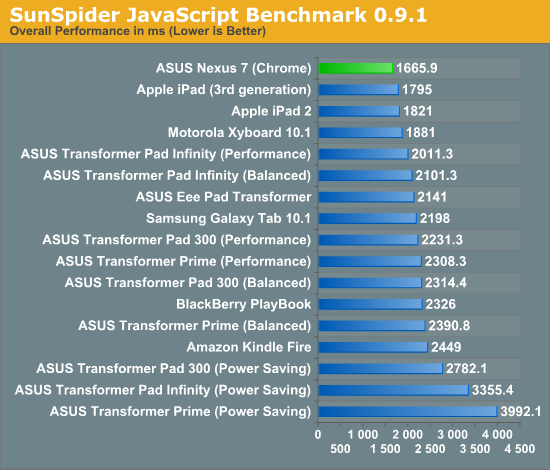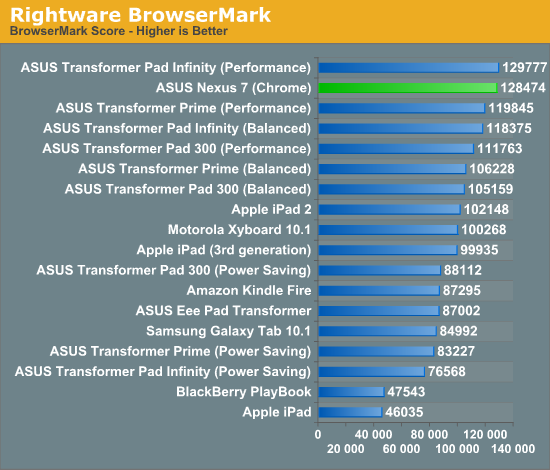The Google Nexus 7 Review
by Anand Lal Shimpi & Brian Klug on July 26, 2012 11:35 AM ESTThe SoC & Performance
While Amazon chose TI's OMAP 4 for the Kindle Fire, Google and ASUS picked arguably the second best SoC on the market today: NVIDIA's Tegra 3. Keep in mind that high-end ARM SoCs generally sell in the $14 - $25 range per chip, which a fabless semiconductor manufacturer has to split with a foundry. The result is a far cry from the margins NVIDIA is used to making on high-end discrete GPUs. I suspect a desire to make good use of all functional Tegra 3 parts that come back from the fab is the reason why we have so many variants of the Tegra 3.
To date we've seen three Tegra 3 SKUs used in tablets: T30L, T30 and T33. Factor in the smartphone SKUs (AP30, AP33) and it's already a pretty healthy collection for a single chip. The main differences between the 30L, 30 and 33 parts are voltages and clock speeds. I've shown this table in previous articles but I present it here again since T30L is what's in the Nexus 7:
| NVIDIA Tegra 3 | |||||||
| CPU Cores | Max CPU Clock (1 core active) | Max CPU Clock (multiple cores) | GPU Cores | Max GPU Clock | |||
| NVIDIA Tegra 3 (T33) | 4+1 | 1.7GHz | 1.6GHz | 12 | 520MHz | ||
| NVIDIA Tegra 3 (T30) | 4+1 | 1.4GHz | 1.3GHz | 12 | 520MHz | ||
| NVIDIA Tegra 3 (T30L) | 4+1 | 1.3GHz | 1.2GHz | 12 | 416MHz | ||
The loss in performance compared to T30/T33 is marginal at best, at least for most consumer use cases. Four Cortex A9s running at up to 1.3GHz is definitely quick enough for the types of applications you'll run on the Nexus 7. Things can always be faster, but like the Kindle Fire's OMAP 4, the Nexus 7's T30L is good enough for now. Give it another year and we'll see something even faster at this price point. That's the downside of buying anything in the tablet/smartphone space these days unfortunately.
| ASUS Android Tablet Memory Choices | ||||||
| TF Prime | TF Pad 300 | Nexus 7 | TF Pad Infinity | |||
| Memory Capacity | 1GB | 1GB | 1GB | 1GB | ||
| Memory Type | DDR2-1000 | DDR3L-1333 | DDR3L-1333 | DDR3-1600 | ||
| Memory Bandwidth | 4.0GB/s | 5.3GB/s | 5.3GB/s | 6.4GB/s | ||
ASUS selected 1GB of DDR3L-1333 memory for the Nexus 7. This gives it more memory bandwidth than any of the Transformer series of tablets, with the exception of the Transformer Pad Infinity. Since the Tegra 3 SoC only has a single channel memory interface, ASUS had to rely on higher frequency memory to deliver sufficient bandwidth.
Note that the browser performance tests below paint a very good picture for the Nexus 7's performance because Android 4.1 replaces the default web browser with Chrome, with a much faster javascript engine.













118 Comments
View All Comments
Sprchkn - Thursday, July 26, 2012 - link
Except that Flash isn't supported on Jelly Bean... I know, mine arrived yesterday and I tried that. Amazon either needs to release an Android app or move to HTML5.But, I've already cancelled the auto-renewal on my Prime account due to their use of Flash DRM which requires a workaround to install the deprecated HAL package under Gentoo so it's not like I'm married to them. Google actually seems to be the only one that supports both Linux and Android, so I'll just start purchasing my video content from them.
Impulses - Friday, July 27, 2012 - link
Flash works fine on Jelly Bean under Firefox and other browsers, just need to side load it.RamarC - Thursday, July 26, 2012 - link
will allow usb tthumb drive/sd cards to be used with the Nexus 7.WolvenSpectre - Thursday, November 8, 2012 - link
The problem is that it doesn't give you any write capability.Pino - Thursday, July 26, 2012 - link
"213 pixels per inch in a 7 inch display is unique for an Android tablet"Lenovo´s S2007 tablet has such a display and was launched way before the Nexus 7:
http://appserver.lenovo.com.cn/Lenovo_lepadSeries_...
eaanders@cox.net - Thursday, July 26, 2012 - link
The primary advantage of the Nexus 7 is price. If a tablet is so small you need to zoom, the sweet spot is the Galaxy Note. It's half the weight of the 7, fits in your shirt pocket, and combines the features of a phone, a camera, and a small tablet in one unit with the possibility of adding an additional 32 Gb of storage. The Note 2 will be even faster.My netbook will be replaced by a Windows 8 hybrid eventually for full computing power. This and the Galaxy Note are all I will need to do everything mobile.
Sprchkn - Thursday, July 26, 2012 - link
I think it depends on what you're using it for. I bought the Nexus 7 so that I can leave my phone docked up to my stereo and then look up recipes, check email, etc. while I'm in the kitchen cooking. The speakers are a bit weak, but it will probably also see some duty playing movies, again, while I'm cooking or perhaps when I'm on my treadmill. The missing storage hasn't been a problem for me with the way I use my phone and I always have my iPod available for music duty. Besides, for whatever reason, I've always had trouble with the micro SDs and corruption when copying large amounts of data onto them - so I'm actually relieved that Google Play means I no longer have to deal with that.MadMan007 - Thursday, July 26, 2012 - link
An unlocked Galaxy Note is over twice as expensive as the Nexus 7. It's only fair to compare unsubsidized vs unsubsidized pricing. Everyone's needs and wants are different, but the 'if you're going to zoom anyway' point is valid if one were going to get a subsidized phone anyway and can deal with the size of the Note as a phone.hackbod - Thursday, July 26, 2012 - link
Great stuff on the NAND performance, as well as the commentary on the screen configuration. Your reviews are consistently the most detailed and technically accurate I see.One thing that would be interesting to do is NAND performance comparisons with the 16GB model. I believe this uses a different NAND controller, so you should see some different interesting behavior. And since the 16GB model is likely more popular than the 8GB one, this would be relevant to many people.
risa2000 - Friday, July 27, 2012 - link
I would like to see similar tests (flash throughput) done also with smartphones. There has been rumors that there are some significant difference between some (e.g. iPhone and some Androids) and it would be interesting to know also for new WP devices.